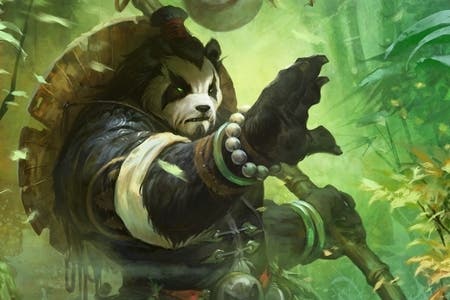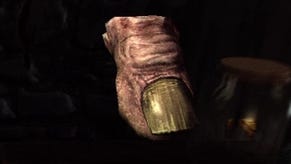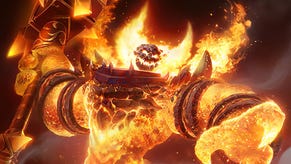World of Warcraft: Mists of Pandaria review
Endangered species?
At first, it seemed juvenile - almost a joke. Prior to the release of Mists of Pandaria, the fourth expansion for World of Warcraft, many players shared the concern that the inclusion of the Pandaren race of anthropomorphic kung-fu pandas represented one dumbing-down too far for this beloved world. It seemed to show a cartoonish disregard for the warmongering history of the eternal feuds between the Alliance, the Horde and whatever imposing faction each expansion introduced.
Quite the reverse. Instead of blunting the established world, the inclusion of this quieter race has allowed Blizzard to tell a story with a maturity and depth any long-term player would have believed Warcraft was incapable of. Until now the game has been defined by adolescent drama, yet this is a remarkably human tale that manages to combine apparently mundane scene-setting with emotional turmoil. Blizzard's ability to take a seemingly inconsequential side-quest and inject genuine heartache further on down the line represents new and welcome ground.
While the storyline overall may be more self-assured, where this new expansion catches a heel on the catwalk is in the laborious nature of that storytelling. Frustratingly, the way your objectives unfold in the continent Pandaria as you progress towards the new level cap of 90 is an evolutionary regression for a game that has learned in recent years to shower its audience in a delicious river of experience opportunities.
The so-called "Christmas tree" questing structure - where a single quest unleashes an avalanche of new objectives, which in turn trickle into further progress opportunities - is gone. In its place is a storyline that's tighter in its telling but jarring in the scarcity of its content. For anyone arriving in this new land directly from the free-flowing adventures of previous expansions, it's a frustrating experience - and one that feels artificially road-blocked in order to discourage progression towards the endgame.
"Instead of blunting the established world, the inclusion of this quieter race has allowed Blizzard to tell a story with a maturity and depth any long-term player would have believed Warcraft was incapable of."
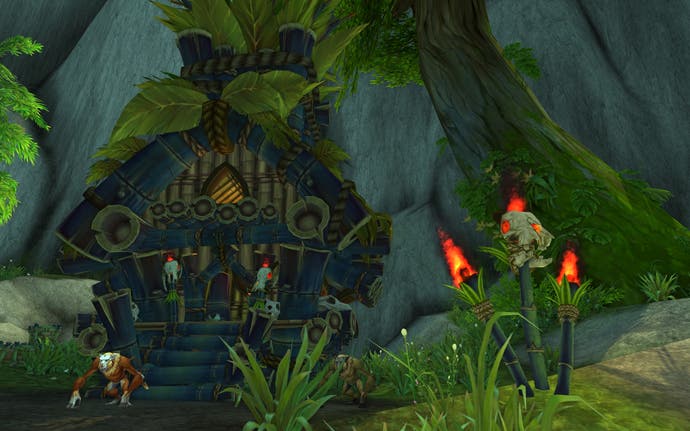
Partly it's a consequence of removing flying skills prior to level 90. Partly it's the sheer reduction of quests on hand at any one time, with no incentive to stray off the beaten path. Finally, there's an over-reliance on the defining quest structure of this latest expansion: investigate, annihilate, and then return once more to do battle against a trio of above-average opponents.
The Chinese-themed landscape of Pandaria initially seems repetitive too, until the resumption of flying at level 90 also brings it to life. This is a continent designed to be viewed from above: the grandeur of the striding Great Wall, the majestic stone guardians and the multi-coloured patchwork paddy fields of the farm-lands.
In contrast to the main continent, the starting area for the Pandaren race - an island on the back of a giant sea turtle - immediately overflows with colour and content, with intricately detailed pagodas adorning the rolling fields. Even the most jaded and cynical WOW player will struggle to stifle a sense of delight at the sight of the meditating Pandarens who sit atop balancing poles and myriad other homages to Asian cinema.
In these early quests, senseis flit around the scenery under the power of animal spirits, players leap across slender poles to ring resonant gongs and aspiring warriors battle to unleash elemental spirits from the caverns deep underground. At the finale of this tightly-tuned introduction, a balloon ride over the island puts the splendour of the artwork and lore on a magnificent pedestal - in a manner that's far more artfully achieved than in the high-end levelling.
"A dramatically revised talents system... does provide pause for thought, but in exchanging one necessary evil for another, Blizzard has not solved the problem of tangible ownership of your character."

With a new starting area and race come a new class, the Monk. Faster and more fluid in combat, it represents a breath of fresh air for the veteran player, albeit one that sits awkwardly alongside the more static combat of the established classes. As with the Death Knight, the Monk takes advantage of two energy resources; energy gained through simplistic combat feeds into chi which can be spent on more flamboyant manoeuvres. This dance between raw power and energy conservation is a satisfying affair that resonates strongly with the thematic positioning of the Pandaren race.
A major impact on every class comes in the form of a dramatically revised talent system that strips away the deep tree branches of the original design and asks players to make role-enhancing choices every 15 levels. Whether you accept Blizzard's position - that this encourages meaningful choices while eliminating bloated, obligatory skill selections - or feel that it represents far too much simplification of WOW's role-playing game will likely depend on your own personal cynicism. It does provide pause for thought, but in exchanging one necessary evil for another, Blizzard has not solved the problem of tangible ownership of your character.
WOW has touched perfection in aspects of its previous expansions: the artwork and themes of Wrath of the Lich King, the freedom of questing opportunities in Cataclysm and the hard-won dungeon progress that gave The Burning Crusade its brutal but rewarding pace. It's yet, however, to bring all of these moments together into one glorious whole - and in the max-level heroic dungeons of Pandaria, the game still struggles to find its Goldilocks moment between adversity and accessibility.
"In the Heroic dungeons of Pandaria, the game still struggles to find its Goldilocks moment between adversity and accessibility."
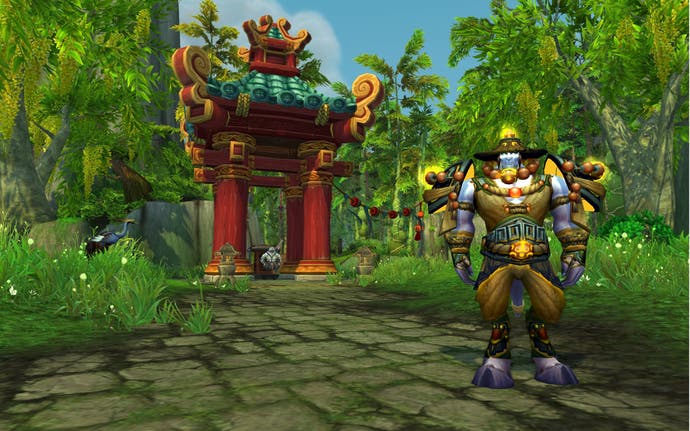
After the cool reception for Wrath's breezy heroics, Cataclysm swung the other way and saw the developer stick resolutely to its guns as players demanded a reprieve from the sometimes arbitrary precision teamwork required to succeed in many of the encounters. In Pandaria, the see-saw swings back: even equipped with the lightest of endgame equipment, there's little more than a handful of deaths to separate you from success on your first attempt.
While the challenge may be a little too easy, the dungeon encounters continue to evolve in imagination as damage-dealers mount turrets to attack a boss's weak spot, or the entire group dances through a fireworks display of cavern traps. Once these novelties have worn off, the non-raiding glory-seeker can focus on the new Challenge mode where dungeon equipment is normalised and a racing clock determines both your prestige on your server and your cosmetic rewards.
A new type of content altogether arrives in the form of Scenarios, which offer near-immediate participation in instanced, three-player adventures, free of the requirements to first assemble a tank, a healer and a handful of damage-dealers. These frantic elite brawls lead you deeper into the lifestyle and culture of the Pandarens, rescuing ale festivals from invading monkeys or trawling through crypts to vanquish elemental forces. Tightly designed and brief, they generously reward you with equipment that's not quite as valuable as that you receive from heroics, but still precious enough to confer a sense of progress.
Pandaria's greatest endgame achievement takes place behind the scenes, however. Previous expansions have been blighted by the length of queues for dungeons for those filling damage roles - but now, at level 90, you can queue for both a scenario and a dungeon at the same time. The scenario will almost certainly become available first but, once entered, your dungeon queue continues to tick away in the background. Whatever matchmaking magic is happening to ensure that these two pools of players come together just as a scenario concludes works exceptionally well, and you'll barely have a moment's pause between group adventures.
"The new pet battle system... is unquestionably ridiculous within the wider context of the game, but it's also fiendishly compelling and a wonderfully luxurious time-waster."
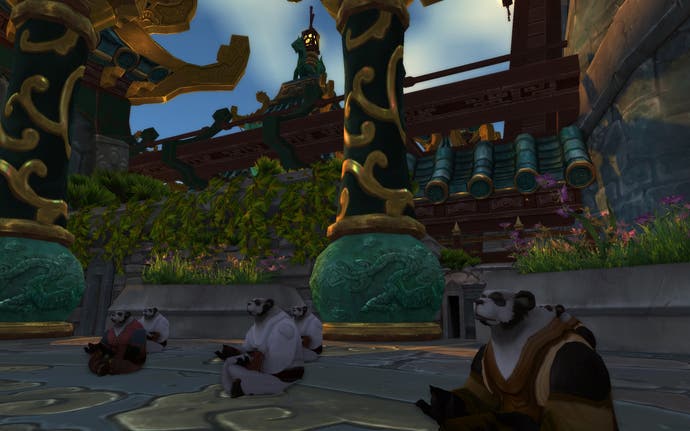
Meanwhile, Pandaria's explosion of endgame daily quests may represent WOW at its most obstinately self-indulgent - dependent as they are on the dominant mechanics of fetch and carry - but each quest is at least brisk and original. In the domain of the Tiller Faction, progress through the daily quests also has a tangible effect on the world as you grow and improve your personalised farmland. Earning an improved reputation with this faction will likely consume the average player for weeks, if not months, to come.
As a further gift to the completist, the new pet battle system adds some much-needed levity to the game, bringing with it a huge, sprawling adventure in its own right that will take you across WOW's many continents in pursuit of new creatures to do battle with and level up. Each critter has been lovingly re-crafted and equipped with a handful of appropriate battle spells, from nibbling rabbits that can unleash a storm of bunnies to the snowball-throwing abilities of your Winterveil gnome. Success in combat adds to your pet's experience and abilities and every creature that can be battled can also be trapped for your collection.
Surprisingly, there's as much delight to be found in these pet battles as there is in any traditional component of the game. Even more unexpected is that it's the veteran players who are rewarded most handsomely, with their collection of unique pets - acquired through long service - assuming a far more meaningful existence. It's unquestionably ridiculous within the wider context of the game, but it's also fiendishly compelling and a wonderfully luxurious time-waster.
"In spite of its successes, Pandaria doesn't quite feel like the finished product - and it still clings doggedly to questing crutches that the likes of Guild Wars 2 have begun, gleefully, to kick away."
For those who prefer grand factional combat between the players themselves, Pandaria introduces two new resource-driven battlegrounds. The Silvershard Mines sees two teams of 10 competing to take control of a series of mine-carts which deliver resource points to the owner. Spawning at the centre of this cavern, the faction-controlled carts can be diverted and delayed by the opposition using switches that alter the course of the track. It's a refreshingly tactical affair that rewards emergent strategy on both sides - and should the action descend into the kind of centre-map brawl that's all too reminiscent of Warsong Gulch, the actions of a few co-ordinated players can still turn the tide of battle.
The Temple of Kotmogu is a more frenzied orgy of out-and-out combat as players compete to control artefacts that increase both the damage received and dealt by the holder. It's hardly a revolution in battleground design, but after the timid evolution of Cataclysm's PVP, both of these new battlegrounds succeed at refreshing a jaded aspect of the game.
For all its stumbles - and there are an awkward handful - Mists of Pandaria nevertheless represents a WOW participating in the massively multiplayer genre rather than revelling in the cult of its own personality. Influences abound; the scenarios are a source of instant gratification sorely underutilised since they appeared, as skirmishes, in The Lord of The Rings Online's Siege of Mirkwood expansion, while the pet battle system nods to any number of turn-based RPGs, including Pokémon of course. Yet Blizzard has managed to stamp its own mark on these features while introducing an unprecedented maturity to its storytelling.
In spite of its successes, though, Pandaria doesn't quite feel like the finished product - and it still clings doggedly to questing crutches that the likes of Guild Wars 2 have begun, gleefully, to kick away. The true impact of that now-archaic questing experience, so fractured on the long road to level 90, won't likely be apparent until players take a second character through the journey. Thankfully there are treasures in abundance at the end of that often frustrating adventure - even if most of it lacks the fiendish fever to accompany the fun.
